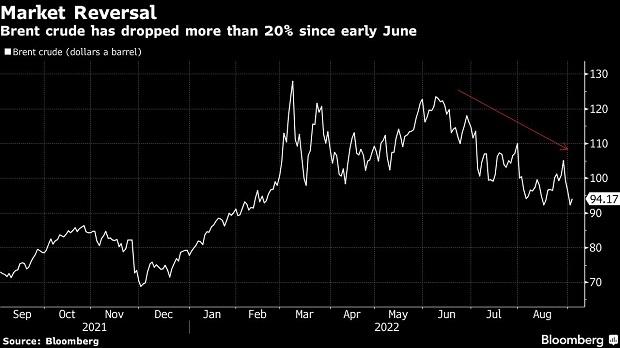The OPEC+ coalition is heading into unfamiliar territory.
After spending two years gradually feeding idle oil production back into the post-pandemic world, Saudi Arabia and its partners are facing a different market. The narrative that’s dominated the last few months — pressure from key consumers like the US to tame inflation by ramping up supply — is shifting toward concerns about a global economic slowdown.
Recent gyrations, including a drop of more than 20% in Brent crude since early June, have prompted Riyadh to say an output cut could be necessary.
Confronted with so much uncertainty, the Organization of Petroleum Exporting Countries and its partners are widely expected to keep production steady when they meet on Monday. Even so, Saudi Energy Minister Prince Abdulaziz bin Salman often likes to surprise observers, and OPEC+ delegates privately say that all options remain on the table.
“OPEC+ has a greater need to consider a widened range of scenarios at this meeting,” said Christyan Malek, global head of energy strategy at JPMorgan Chase & Co.. “It’s an environment of heightened macroeconomic volatility led by conflicting data points on demand and recession. But it’s also a tightening oil market, with supply uncertainties from Libya to Iraq.”
Much has changed since OPEC+ met a month ago, when it had to consider exhortations from President Joe Biden to open the taps wider.
Oil prices have rounded off their longest decline since 2020, imperiling the unprecedented windfall enjoyed by the Saudis and their partners. China, the biggest oil importer, has exhibited signs of an “alarming” economic slowdown, while the US has skirted close to recession. Meanwhile, there’s been a resumption of nuclear talks that could revive crude flows from OPEC member Iran.
The resulting price fluctuations prompted Saudi Arabia’s Prince Abdulaziz to announce last month that crude futures have detached from the realities of supply and demand, and that new output curbs could be the best tool to restore equilibrium. This message was roundly endorsed by fellow OPEC+ members.
“The market is in a state of schizophrenia, and this is creating a type of a yo-yo market,” the prince said in an interview on Aug. 22. “OPEC+ has the commitment, the flexibility, and the means” to “deal with such challenges.”
Brent crude futures are trading near $94 a barrel in London, a slump of 24% in less than three months.

Hold Steady
Nonetheless, OPEC+ is expected to ride out the current price lull, with sixteen of 20 of traders and analysts surveyed by Bloomberg predicting the group will hold steady when it decides October output levels at an online gathering on Monday.
From Goldman Sachs Group Inc. to Shell Plc, there’s a widespread view across the industry that global markets will tighten as China’s re-emergence from lockdowns boosts demand.
While supplies from OPEC+ nation Russia have so far proven surprisingly resilient following the invasion of Ukraine, they are expected to falter over the new few months with the onset of European Union sanctions in early December. Unrest in another alliance member, Iraq, and tumult in Libya have only underscored the fragility of global output.
OPEC’s newly-appointed Secretary-General, Haitham Al Ghais, said that he expects a “bullish” surge of demand from consumers eager to resume normalcy after two-years of Covid restrictions. An OPEC+ committee that met earlier this week revised its forecasts to show a supply shortfall in the fourth quarter.
“It would be odd to cut output whilst their numbers are showing a tighter-than-expected market,” said Warren Patterson, head of commodities strategy at ING Groep NV in Singapore.
US Relations
Cutting production would also be a politically sensitive move for OPEC+.
President Biden gambled his political credibility with a landmark visit in July to Saudi Arabia, where he greeted Crown Prince Mohammad bin Salman with a symbolic fist-bump of reconciliation after years of estrangement over the kingdom’s human rights record.
While Biden declared he was confident of assistance from the Saudis to bring down gasoline prices, OPEC+ instead responded with a negligible supply increase of just 100,000 barrels a day for September. Following this paltry gesture with an output cut could further strain Riyadh’s often-fraught relationship with Washington.
Another source of uncertainty comes from OPEC nation Iran, which remains locked in negotiations to revive a nuclear accord and remove US sanctions on its petroleum sales. A successful agreement could add more than 1 million barrels a day onto world markets, according to the International Energy Agency.
There’s still some work to be done before that could happen, with US officials describing Tehran’s latest position in the discussions as “not constructive.”
“But OPEC+ will react quickly if a deal is concluded” between the US and Iran, said Raad Alkadiri, managing director for energy at consultants Eurasia Group Ltd. But for now “the group will stay its hand until there is more clarity about the outcome of negotiations.”
–With assistance from Serene Cheong, Yongchang Chin and Sharon Cho.
Stay connected with us on social media platform for instant update click here to join our Twitter, & Facebook
We are now on Telegram. Click here to join our channel (@TechiUpdate) and stay updated with the latest Technology headlines.
For all the latest Business News Click Here
For the latest news and updates, follow us on Google News.
